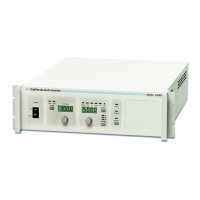5 Principle of Operation
5.1 General
An explanation of the circuits in the AC Source is given in this section. Refer to the block
diagram of the system, Figure 5-1.
5.2 Overall Description
Input power at the rear panel is routed through the EMI filter, A11, and circuit breaker to the
high current rectifier, CR1, and the DC Supply assembly, A4. The various DC supply outputs
then go to the Mother board, A5, then are directed to other modules.
The Oscillator assembly, A1 and A2, generates the oscillator and control signals, and
measures the output voltage, current, etc.
The Amplifier modules, A7, A8, A9, take DC supply voltages and input signals from the
Mother board. The high power amplifier outputs are sent via the Mother board and
Range/Relay bard, to the output transformer primaries, T1, T2, T3.
The Range/Relay board is identified as A6. This board configures the secondaries of the
output transformers for the correct output voltage range. The output of the Range/Relay
board is directed to the Output assembly, A12.
The Output assembly holds the output relays and output terminal strip, TB2. The output of
the AC Power Source is taken from the terminal strip through the rear panel.
5.3 DC Supply
This assembly is identified as A4. It generates the high power +300 VDC supply used by the
amplifiers.
The DC supply also has circuits that generate auxiliary DC voltages for the low power circuits
of the 2003RP:
1. +26V (output referred) supply for relays and fans.
2. +18V, -18V (output referred) supply for oscillator control circuits
3. +15VSW, -15VSW (input referred) supplies for amplifier control circuits
4. +15VSW1 (input referred) supply for amplifier gate drive
5. +8VISO (SELV) supply for RS232/GPIB board

